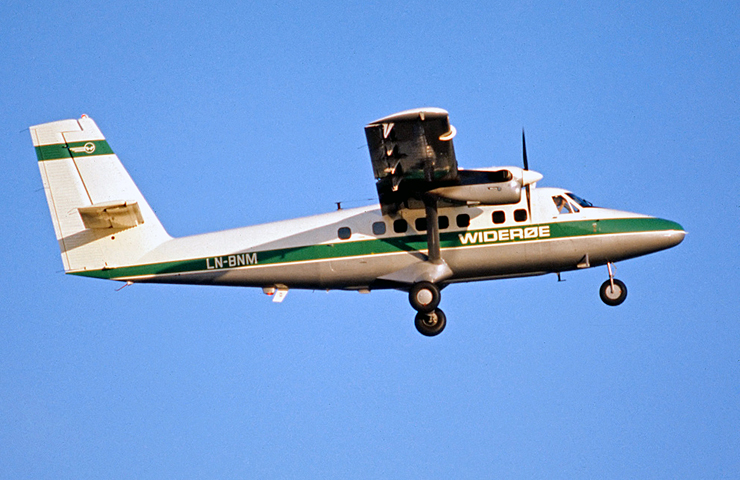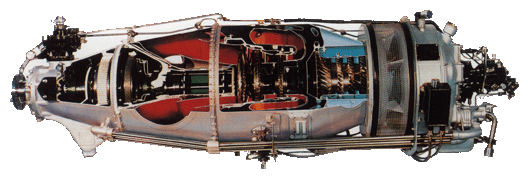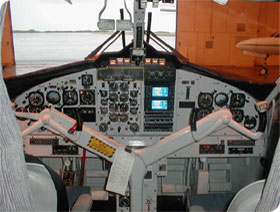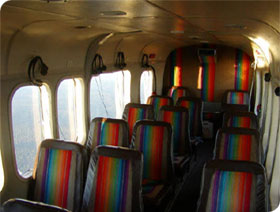|

DHC-6-300 Twin Otter LN-BNM (s/n 408)
Widerøe
Photo: © Jan-Olav Martinsen 1974
Large
photo at www.airpics.com
|
Series Comparison
|
SERIES
1
Prototype
and 4 pre-production aircraft (s/n 1- 5). Maximum number of seats limited to
16 by the approved seating arrangement. PT6A-20 engine.
SERIES
100
S/n 6 -115. These aircraft had a
larger door on the left side of the cabin (56 x 50 in vs. 46.5 x 45.5 in
on the Series 1), and provisions for double seats on the right side of
the cabin, thereby increasing the maximum number of seats to 21. The
Series 1 and 100 were characterized by a "Short Nose" with a
baggage compartment door on the front of the aircraft. SERIES
200
S/n 116 - 230 (Except 130
& 210 which were converted to Series 300). The Series 200 was
characterized by a longer nose containing a larger forward baggage
compartment, an extended (shelf) rear baggage compartment and larger
baggage compartment doors. SERIES 300
S/n 130, 210, 231 - 844. This was the final production model and is characterized by
having PT6A-27 engines, higher operating weights, escape hatches in the
forward part of the cabin and deletion of the roof hatch. Conversion to
a floatplane requires installation of the "short nose". The
maximum number of seats is 22. Certification was completed to CAR-3 and
SFAR-23 regulations.
Significant variants within these series include:
SERIES 110, 210, 310
Certificated to
British CAA. requirements, including short field performance. SERIES
320
Certificated to Australian DCA. requirements.
|
SERIES
|
1
|
100/200
|
300
|
|
Serial Numbers
|
1 thru 5
|
6 thru 115
116 thru 230
|
130, 210
231 thru 844
|
|
Engines
|
PT6A-20
|
PT6A-20
|
PT6A-27
|
|
MAXIMUM
POWER (S/L,
ISA, Static)
|
|
Takeoff (5
Minutes)
|
550
SHP
|
550
SHP
|
620
SHP
|
|
Max.
Continuous
|
550
SHP
|
550
SHP
|
620
SHP
|
|
Max. Climb
|
538
SHP
|
538
SHP
|
588
SHP
|
|
Max. Cruise
|
495
SHP
|
495
SHP
|
588
SHP
|
|
WEIGHT
(lbs)
|
|
Maximum
Takeoff
|
11,000
|
11,579
|
12,500
|
|
Maximum
Landing
|
11,000
|
11,400
|
12,300
|
|
0.W.E.
(Typical)
|
7,000
|
7,200
|
7,440
|
|
Wing Loading
(lbs/sq ft)
|
26.2
|
27.6
|
29.8
|
|
Power
Loading (Ibs/shp)
|
10.0
|
10.5
|
10.1
|
|

"184" DHC-6 Series 200 ("long nose")
719 Squadron
Bodø, Norway, 1987
Photo: © Steinar Saevdal
|
DHC-6 Twin Otter Series 300
|
|
More text coming...
|
ENGINES
|
|
Engines
|
2 x P&WC
PT6-A27 (Turboprop)
|
|
Shaft
Horsepower
|
620
|
|
Propellers
|
Hartzell
3-Bladed, Full-Feathering, Reversible
|
|
EXTERNAL
DIMENSIONS
|
|
Wing Span
|
65 ft 0 in
|
|
Length
|
51 ft 9 in
|
|
Height
|
19 ft 6 in
|
|
Tailplane
Span
|
.20 ft 8 in
|
|
Wheel Track
|
12 ft 2 in
|
|
Wheel Base
|
14 ft 10.5
in
|
|
Wing Area
|
420.0 sq ft
|
|
Aileron Area
|
33.2 sq ft
|
|
Flap Area
|
112.2 sq ft
|
|
Fin Area
|
48.0 sq ft
|
|
Rudder Area (Incl.
tab)
|
34.0 sq ft
|
|
Tailplane
Area
|
100.0 sq ft
|
|
Elevator
Area (Incl. tabs)
|
35.0 sq ft
|
|
INTERNAL
DIMENSIONS
|
|
Cabin Length
|
18 ft 6 in
|
|
Maximum
Width
|
63.25 in
|
|
Maximum
Height
|
59.0 in
|
|
Floor Area
|
80.2 sq ft
|
|
Volume
|
384 cu ft
|
|
Cabin Doors
- Left
|
56 x 50 in
|
|
Cabin Doors
- Right
|
30 x 45.5 in
|
|
Total
Baggage Volume
|
126 cu ft
|
|
Passenger
Seats (max)
|
22
|
|
PERFORMANCE
|
|
Maximum
Operating Speed
|
170 Knots
|
|
Maximum
Cruise Speed at 10,000 ft
|
182 Knots
|
|
Stalling
Speed
|
56 Knots
|
|
Rate of
Climb at SL - 2 Engines
|
1,600 ft/min
|
|
Rate of
Climb at SL - 1 Engine
|
340 ft/min
|
|
Service
Ceiling - 2 Engines
|
26,700 ft
|
|
Service
Ceiling - 1 Engine
|
11,600 ft
|
|
Payload/Range
(Normal Tanks, 45 Min Reserve):
|
100 NM /
4,280 lb
400 NM /
3,250 lb
775 NM / 0
lb
|
| |
|
More text coming....
|

OY-POF (s/n 235) DHC-6 Series 300
Greenlandair Charter (now Air
Greenland)
Bodø, Norway, 1987
Photo: © Steinar Saevdal
|
The Vistaliner®
|
 In the late
1970's, owners of Grand Canyon
Airlines, John Seibold and
Elling Halvorson, realized
that the air tour industry
needed a safer, stronger,
quieter, more reliable, and
much more environmentally
friendly aircraft. They sensed
a real need to address safety
issues and concerns regarding
noise and pollution generated
while air touring over such a
precious environment as the
magnificent Grand Canyon. At
the time, GCA owned and
operated a fleet of thirteen
(13) older Cessna C-207
airplanes and were flying
nearly 80,000 passengers a
year. These airplanes had five
cramped passenger seats, very
small windows, one noisy
piston driven engine, no
climate controls (except for
small air vents), and just one
pilot at the controls of every
flight. Both being pilots
themselves, Seibold and
Halvorson knew that the
density altitude and power
limitations of those types of
aircraft were not ideal over
the Canyon on a hot day with a
full load of fuel and
passengers, especially
departing a high-altitude
airport such as the Grand
Canyon National Park Airport
(6500 ft above sea level).
While the Canyon is always
spectacular, an air tour in
the back seat of a Cessna 207
was often just an
uncomfortable ride. Seibold,
also founder and then owner of
the modern Scenic Airlines in
Las Vegas (founded 1967), and
Halvorson, founder and owner
of Papillon Grand Canyon
Helicopters (founded 1965),
were both committed to
carrying on the legacy of
pioneering the industry which
their small airline had
created fifty years earlier.
They were (and still are) 100%
committed to the future of the
air tour industry and the
benefits they provide,
especially at the Grand
Canyon. In the late
1970's, owners of Grand Canyon
Airlines, John Seibold and
Elling Halvorson, realized
that the air tour industry
needed a safer, stronger,
quieter, more reliable, and
much more environmentally
friendly aircraft. They sensed
a real need to address safety
issues and concerns regarding
noise and pollution generated
while air touring over such a
precious environment as the
magnificent Grand Canyon. At
the time, GCA owned and
operated a fleet of thirteen
(13) older Cessna C-207
airplanes and were flying
nearly 80,000 passengers a
year. These airplanes had five
cramped passenger seats, very
small windows, one noisy
piston driven engine, no
climate controls (except for
small air vents), and just one
pilot at the controls of every
flight. Both being pilots
themselves, Seibold and
Halvorson knew that the
density altitude and power
limitations of those types of
aircraft were not ideal over
the Canyon on a hot day with a
full load of fuel and
passengers, especially
departing a high-altitude
airport such as the Grand
Canyon National Park Airport
(6500 ft above sea level).
While the Canyon is always
spectacular, an air tour in
the back seat of a Cessna 207
was often just an
uncomfortable ride. Seibold,
also founder and then owner of
the modern Scenic Airlines in
Las Vegas (founded 1967), and
Halvorson, founder and owner
of Papillon Grand Canyon
Helicopters (founded 1965),
were both committed to
carrying on the legacy of
pioneering the industry which
their small airline had
created fifty years earlier.
They were (and still are) 100%
committed to the future of the
air tour industry and the
benefits they provide,
especially at the Grand
Canyon.
Seibold, with his
engineering background,
considered several different
types of aircraft for the new
fleet of GCA and Scenic. He
borrowed a DeHavilland Twin
Otter airplane from a friend
in 1980 for the summer. The
Twin Otter, one of the most
famous Canadian made aircraft,
is known world-wide as a truly
incredible aircraft with
extremely unique flying
characteristics and was the
perfect combination of both
strength, reliability,
comfort, and quiet. The only
thing Seibold did not
particularly care for was the
original, small
"port-hole" style
windows which were factory
original and made it difficult
for passengers to see views
below. After extensive
research and assistance from
RW Martin Aviation and CAE
Engineering, it was determined
that Seibold was right, and
that it could be
"re-modeled" with
much larger, sightseeing style
windows without compromising
the integrity of the rugged
Twin Otter. Ultimately, this
led to the creation of what
Seibold and Halvorson named
the "VISTALINER"
after the incredible panoramic
vista-views offered to every
passenger on the aircraft. The
19 passenger configuration
also allowed GCA to fly the
same number of passengers over
the Canyon with just 1/3rd the
number of flights compared to
what their previous fleet
would allow. The cost was
enormous (one Twin Otter is
valued at the price of nearly
ten (10) Cessna 207 airplanes)
but Scenic Airlines and Grand
Canyon Airlines began a quest
of acquiring Twin Otter
aircraft from around the world
and modifying them with their
newly-patented VISTALINER
configuration.
Since the first
VISTALINER went online at
Grand Canyon Airlines in
March, 1983 [CELEBRATING OVER
20 YEARS], the ownership has
modified over 40 of these
aircraft in the VISTALINER
configuration. The STC (or
patent) on these special
modifications are still owned
by Seibold / Halvorson. The
VISTALINER is now known
world-wide to be the ultimate
limousine of air tour aircraft
and are leased world wide. See
other differences that make
GCA unique and the preferred
air tour operator.
Partial
List of Major Differences
& Benefits of the GCA
VISTALINER
-
 High
wings with no
obstructions, reengineered
with the largest flat,
un-tinted panoramic
windows on any air tour
aircraft offering
unbelievable views from
every seat. Perfect for
sightseeing and
photography! High
wings with no
obstructions, reengineered
with the largest flat,
un-tinted panoramic
windows on any air tour
aircraft offering
unbelievable views from
every seat. Perfect for
sightseeing and
photography!
-
Configured
with 19 comfortable, roomy
seats, it is perfect for
groups of any size
(literally!) Because GCA
led the way in voluntarily
upgrading its fleet of
single engine aircraft
(5-6 seats each) to the 19
passenger VISTALINERS,
Grand Canyon Airlines
flies just one flight over
the Canyon for what
previously required three
flights to accommodate the
same number of passengers.
The VISTALINER has
significantly reduced the
flight intrusions and
noise generated by 2/3rds
at GCA's operation.
-
Two
extremely powerful,
TURBINE driven engines
(not piston). Extremely
strong, reliable, and
quiet Pratt & Whitney
PT6A-27. Very
significant difference in
strength and exterior
noise compared to
competitor's aircraft.

-
Passenger
Cabin is climate
controlled with heat and
air conditioning to allow
for the most comfortable
ride.
-
TWO
highly qualified and
trained pilots in control
of EVERY Vistaliner
flight. (GCA also has
higher pre-hire minimum
requirements and
qualifications for its
Captains and First
Officers than that of its
competitors).
-
 Digital
narration system on board
with BOSE* Tri-Port
headphones at each
passenger seat for music
and information throughout
the flight. GCA also has
their Grand Canyon tour
narration in several
languages [Spanish,
Japanese, German, Italian,
French, Dutch, English,
Korean]. Digital
narration system on board
with BOSE* Tri-Port
headphones at each
passenger seat for music
and information throughout
the flight. GCA also has
their Grand Canyon tour
narration in several
languages [Spanish,
Japanese, German, Italian,
French, Dutch, English,
Korean].
-
Grand
Canyon Airlines aircraft
have a substantially
better communications
system and avionics
package as well as
numerous other special
upgrades.
-
Each seat is also equipped
with an adapter jack
outlet where upon request,
passenger can connect
their personal camcorders
or digital video cameras
(via the mic jack)
allowing the digital tour
narration and music to be
cleanly recorded without
feedback or background
noise, making wonderful
souvenir videos!
-
Each
aircraft has
high-technology weather
radar equipment, terrain
and collision avoidance
systems, GPS navigation
systems, de-ice / anti-ice
system with fully
instrument flight rule
capable flying.
-
Passenger
cabin is large and roomy
with high ceiling,
allowing for a more
comfortable ride. Interior
is immaculate. GCA is
proud to specialize in
assisting physically
challenged and impaired
Grand Canyon visitors in
the large VISTALINER to be
able to experience the
Canyon by air. The
aircraft is large and
stable, generally allowing
for a much smoother ride
than smaller aircraft.
-
 Each
VISTALINER is maintained
thoroughly each day by a
first-rate internal
maintenance team. All
maintenance (general and
major) is done in-house in
our 10,000 square foot
hangar and maintenance
facility. Below is a
picture of a thorough
inspection and
refurbishment after adding
the large windows. Each
VISTALINER is maintained
thoroughly each day by a
first-rate internal
maintenance team. All
maintenance (general and
major) is done in-house in
our 10,000 square foot
hangar and maintenance
facility. Below is a
picture of a thorough
inspection and
refurbishment after adding
the large windows.
-
Each
GCA VISTALINER is valued
at over $1.6 million
dollars. Just one is worth
nearly the entire previous
GCA fleet of thirteen (13)
Cessna 207 airplanes.
-
GCA
employs "quiet
technology". By
adding a specially
designed fourth blade to
the already quiet
propeller, this
successfully reduced the
exterior noise by an
additional 66%. The
Federal Aviation
Administration and the
National Park Service
consider the VISTALINER to
be the quietest aircraft
currently flying tours of
Grand Canyon.
-
The
Twin Otter VISTALINER is
considered a STOL (Short
Takeoff and Landing)
aircraft, making it a
perfect aircraft for
short, unimproved, remote
strips and airfields. It
also allows for slow
(approximately 90 knots)
stable flight during tours
for superb viewing.
-
GCA
owns a fleet of six (6)
VISTALINER aircraft and
has an exclusive operation
of this type of aircraft
on tours from Grand Canyon
and Scottsdale. GCA is
capable of handling up to
114 passengers per
departure.
- The VISTALINER has large
cargo hauling capability
in its baggage
compartments.
-
19
passengers per flight
allow GCA to operate a
lower unit cost per
passenger, thereby
allowing GCA to provide
the most affordable tours
offered.
To see more,
please click here.

Grand
Canyon Airlines, Inc.
PO Box 3038
Grand Canyon, Arizona
86023-3038
USA
Corp Office: (928) 638-2463
Corp Fax: (928) 638-9461
|
|



 In the late
1970's, owners of Grand Canyon
Airlines, John Seibold and
Elling Halvorson, realized
that the air tour industry
needed a safer, stronger,
quieter, more reliable, and
much more environmentally
friendly aircraft. They sensed
a real need to address safety
issues and concerns regarding
noise and pollution generated
while air touring over such a
precious environment as the
magnificent Grand Canyon. At
the time, GCA owned and
operated a fleet of thirteen
(13) older Cessna C-207
airplanes and were flying
nearly 80,000 passengers a
year. These airplanes had five
cramped passenger seats, very
small windows, one noisy
piston driven engine, no
climate controls (except for
small air vents), and just one
pilot at the controls of every
flight. Both being pilots
themselves, Seibold and
Halvorson knew that the
density altitude and power
limitations of those types of
aircraft were not ideal over
the Canyon on a hot day with a
full load of fuel and
passengers, especially
departing a high-altitude
airport such as the Grand
Canyon National Park Airport
(6500 ft above sea level).
While the Canyon is always
spectacular, an air tour in
the back seat of a Cessna 207
was often just an
uncomfortable ride. Seibold,
also founder and then owner of
the modern Scenic Airlines in
Las Vegas (founded 1967), and
Halvorson, founder and owner
of Papillon Grand Canyon
Helicopters (founded 1965),
were both committed to
carrying on the legacy of
pioneering the industry which
their small airline had
created fifty years earlier.
They were (and still are) 100%
committed to the future of the
air tour industry and the
benefits they provide,
especially at the Grand
Canyon.
In the late
1970's, owners of Grand Canyon
Airlines, John Seibold and
Elling Halvorson, realized
that the air tour industry
needed a safer, stronger,
quieter, more reliable, and
much more environmentally
friendly aircraft. They sensed
a real need to address safety
issues and concerns regarding
noise and pollution generated
while air touring over such a
precious environment as the
magnificent Grand Canyon. At
the time, GCA owned and
operated a fleet of thirteen
(13) older Cessna C-207
airplanes and were flying
nearly 80,000 passengers a
year. These airplanes had five
cramped passenger seats, very
small windows, one noisy
piston driven engine, no
climate controls (except for
small air vents), and just one
pilot at the controls of every
flight. Both being pilots
themselves, Seibold and
Halvorson knew that the
density altitude and power
limitations of those types of
aircraft were not ideal over
the Canyon on a hot day with a
full load of fuel and
passengers, especially
departing a high-altitude
airport such as the Grand
Canyon National Park Airport
(6500 ft above sea level).
While the Canyon is always
spectacular, an air tour in
the back seat of a Cessna 207
was often just an
uncomfortable ride. Seibold,
also founder and then owner of
the modern Scenic Airlines in
Las Vegas (founded 1967), and
Halvorson, founder and owner
of Papillon Grand Canyon
Helicopters (founded 1965),
were both committed to
carrying on the legacy of
pioneering the industry which
their small airline had
created fifty years earlier.
They were (and still are) 100%
committed to the future of the
air tour industry and the
benefits they provide,
especially at the Grand
Canyon. High
wings with no
obstructions, reengineered
with the largest flat,
un-tinted panoramic
windows on any air tour
aircraft offering
unbelievable views from
every seat. Perfect for
sightseeing and
photography!
High
wings with no
obstructions, reengineered
with the largest flat,
un-tinted panoramic
windows on any air tour
aircraft offering
unbelievable views from
every seat. Perfect for
sightseeing and
photography!
 Digital
narration system on board
with BOSE* Tri-Port
headphones at each
passenger seat for music
and information throughout
the flight. GCA also has
their Grand Canyon tour
narration in several
languages [Spanish,
Japanese, German, Italian,
French, Dutch, English,
Korean].
Digital
narration system on board
with BOSE* Tri-Port
headphones at each
passenger seat for music
and information throughout
the flight. GCA also has
their Grand Canyon tour
narration in several
languages [Spanish,
Japanese, German, Italian,
French, Dutch, English,
Korean]. Each
VISTALINER is maintained
thoroughly each day by a
first-rate internal
maintenance team. All
maintenance (general and
major) is done in-house in
our 10,000 square foot
hangar and maintenance
facility. Below is a
picture of a thorough
inspection and
refurbishment after adding
the large windows.
Each
VISTALINER is maintained
thoroughly each day by a
first-rate internal
maintenance team. All
maintenance (general and
major) is done in-house in
our 10,000 square foot
hangar and maintenance
facility. Below is a
picture of a thorough
inspection and
refurbishment after adding
the large windows.